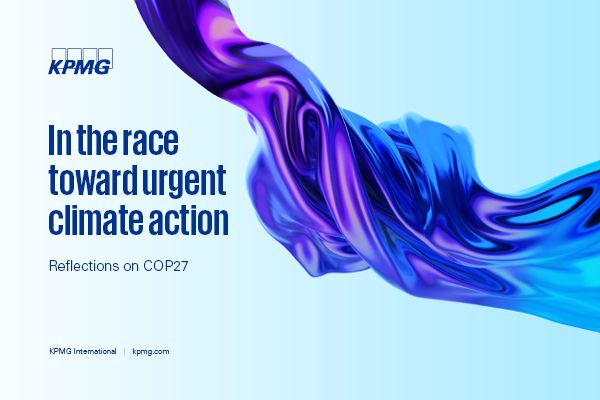The 27th Annual Conference of the Parties (COP27) of the United Nations Framework Convention on Climate Change (UNFCCC) took place in Sharm el-Sheikh, Egypt, in November 2022. The purpose of this COP was to focus on implementing the various goals and pledges made during the 26th COP. It was concluded that nearly 200 countries had agreed to the Sharm el-Sheikh Implementation Plan1 at the conference.
COP27 may not have produced an ambitious agreement, but it remains an important step in the right direction. The “Loss and Damage” fund was established to support vulnerable countries most affected by the impact of the climate crisis, while not losing sight of the priority to phase out fossil fuels.
A summary of some of the key developments at COP27 is presented in this report as well as KPMG specialists perspectives on how these developments may affect organizations including KPMG firms' clients. Although progress has been made in some key areas, there is still much to be done.
Key takeaways
- Beyond simply being a “Conference of the Parties”, COP is increasingly becoming a “Convening of Practitioners”, with numerous civil society actors considering what solutions are feasible, affordable, investable and scalable. If we really want to make COP an “implementation COP”, it is important to build an ecosystem in which all social actors contribute and know how to create impact through co-creation. Shared responsibility and leadership are central to this, but so is the role of innovation, new forms of financing, and valuing the symbiosis between mitigation and adaptation differently.
- Innovation is about embracing complexity which, on the one hand, is about better implementing what already exists and, on the other hand, coming up with new research questions and solutions to address the many remaining question marks. Innovation is also about new value and revenue models, about a just transition, about what transition and transformation strategies in terms of energy and decarbonization mean, and about how various forms of blended finance help reduce risk and increase investment in long-term value.
- Transparency and a clear regulatory framework help to set minimum conditions while also encouraging ambition and investment. The symbiosis between mitigation and adaptation concerns valuing nature, biodiversity and ecosystem services differently and how these help increase the resilience of society, the economy and value chains. It will soon become clear that the agenda of COP26 (Climate), and that of COP15 (Nature and Biodiversity), can no longer be regarded as separate agendas, and that the risk and investments involved are a joint public-private responsibility.
- KPMG helps clients from both public and private sectors bring clarity to how - within a legal framework - actors, solutions and investments can be linked within a rapidly changing market. And, the only way to do this is together. In this report, we zoom in on some key topics, what they mean for our clients and how we can help make net-zero scenarios a reality.
The 1.5°C goal
To limit global temperature increases to 1.5°C, the following question must be asked: where does the world find the resources to do so? In the 2015 Paris Agreement, there are two temperature goals: to keep the rise "well below 2°C" from pre-industrial levels and to pursue efforts to keep it at 1.5°C. Because of the growing consensus that 1.5°C should be the target, at COP26 in Glasgow, countries agreed to focus on a 1.5°C limit.
According to the COP27 implementation plan, rapid, deep and sustained emissions reductions and a substantial increase in climate finance are essential to reduce global warming to 1.5°C. Despite this, the plan does not outline the additional actions, solutions, and pathways required to reach this goal.
The concept of keeping temperature rises to 1.5°C was kept alive — but only just — and there are certainly some doubts as to whether this goal can be achieved.
Other highlights from COP27 include:
The establishment of a Loss & Damage fund to deal with the impacts of climate change in some of the world’s most vulnerable countries and territories.
Announcements on corporate transition plans and the publication of a report on greenwashing from the UN High-Level Expert Group.
Recognition of the need to scale up climate finance and various new initiatives to help accelerate this, including carbon markets. Many parties expressed concern about failing to meet the US$100 billion climate finance funding target.
The focus on climate adaptation is on the Sharm-El-Sheikh Adaptation Agenda, launched in partnership with the High-Level Champions and the Marrakech Partnership for Global Climate Action.2
While COP27 resulted in progress in several vital areas, it failed to address some critical measures needed to keep the 1.5°C scenario alive.
Already the focus is turning to COP28, where there will be even greater pressure to deal with this crucial issue. Developments on the Loss & Damage and adaptation and resilience fronts are welcome. A vital issue is mobilizing private capital to support limited public sector funding.
Events such as COP27 help add much-needed momentum to the climate change agenda. We welcome the sense of urgency evident on the ground at COP27 and hope it does not go away. It seems the climate agenda has crossed a significant hurdle. The era of big commitment announcements is over, and the challenge is demonstrating tangible actions on the ground. Tangible actions need to be seen in the lead-up to and at COP28 for the 1.5°C goal to have a chance of survival.
Explore
1 Sharm el-Sheikh Implementation Plan: https://unfccc.int/documents/624441
2 Sharm-El-Sheikh Adaptation Agenda: https://climatechampions.unfccc.int/wp-content/uploads/2022/12/SeS-Adaptation-Agenda_Complete-Report_COP27-.pdf








